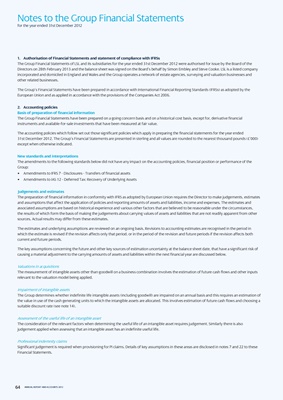
Notes to the Group Financial Statements
for the year ended 31st December 2012
1. Authorisation of Financial Statements and statement of compliance with iFRSs
The Group Financial Statements of LSL and its subsidiaries for the year ended 31st December 2012 were authorised for issue by the Board of the
Directors on 28th February 2013 and the balance sheet was signed on the Board’s behalf by Simon Embley and Steve Cooke. LSL is a listed company
incorporated and domiciled in England and Wales and the Group operates a network of estate agencies, surveying and valuation businesses and
other related businesses.
The Group’s Financial Statements have been prepared in accordance with International Financial Reporting Standards (IFRSs) as adopted by the
European Union and as applied in accordance with the provisions of the Companies Act 2006.
2. Accounting policies
Basis of preparation of financial information
The Group Financial Statements have been prepared on a going concern basis and on a historical cost basis, except for, derivative financial
instruments and available-for-sale investments that have been measured at fair value.
The accounting policies which follow set out those significant policies which apply in preparing the financial statements for the year ended
31st December 2012. The Group’s Financial Statements are presented in sterling and all values are rounded to the nearest thousand pounds (£’000)
except when otherwise indicated.
new standards and interpretations
The amendments to the following standards below did not have any impact on the accounting policies, financial position or performance of the
Group:
• Amendments to IFRS 7 - Disclosures - Transfers of financial assets
• Amendments to IAS 12 - Deferred Tax: Recovery of Underlying Assets
Judgements and estimates
The preparation of financial information in conformity with IFRS as adopted by European Union requires the Director to make judgements, estimates
and assumptions that affect the application of policies and reporting amounts of assets and liabilities, income and expenses. The estimates and
associated assumptions are based on historical experience and various other factors that are believed to be reasonable under the circumstances,
the results of which form the basis of making the judgements about carrying values of assets and liabilities that are not readily apparent from other
sources. Actual results may differ from these estimates.
The estimates and underlying assumptions are reviewed on an ongoing basis. Revisions to accounting estimates are recognised in the period in
which the estimate is revised if the revision affects only that period, or in the period of the revision and future periods if the revision affects both
current and future periods.
The key assumptions concerning the future and other key sources of estimation uncertainty at the balance sheet date, that have a significant risk of
causing a material adjustment to the carrying amounts of assets and liabilities within the next financial year are discussed below.
Valuations in acquisitions
The measurement of intangible assets other than goodwill on a business combination involves the estimation of future cash flows and other inputs
relevant to the valuation model being applied.
Impairment of intangible assets
The Group determines whether indefinite life intangible assets (including goodwill) are impaired on an annual basis and this requires an estimation of
the value in use of the cash generating units to which the intangible assets are allocated. This involves estimation of future cash flows and choosing a
suitable discount rate (see note 14).
Assessment of the useful life of an intangible asset
The consideration of the relevant factors when determining the useful life of an intangible asset requires judgement. Similarly there is also
judgement applied when assessing that an intangible asset has an indefinite useful life.
Professional indemnity claims
Significant judgement is required when provisioning for PI claims. Details of key assumptions in these areas are disclosed in notes 7 and 22 to these
Financial Statements.
64 ANNUAL REPORT AND ACCOUNTS 2012